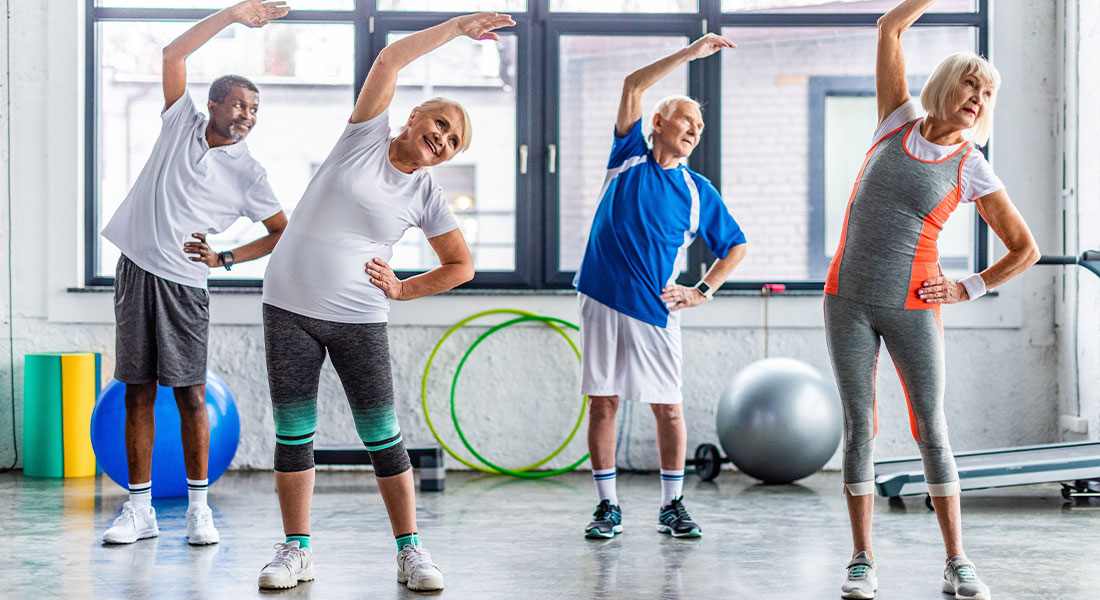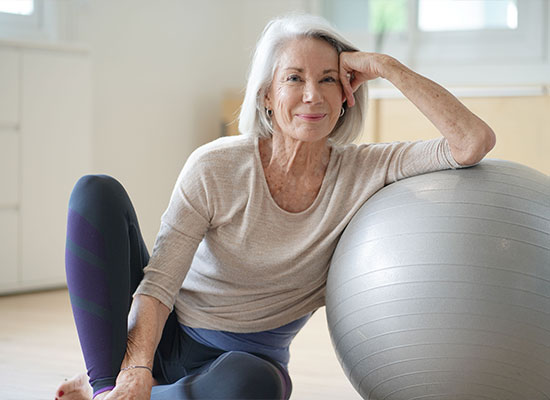 Contact
About Us
Articles
Home
Contact
About Us
Articles
Home

Falls and motor vehicle crashes, both linked to mobility, are the leading causes of injury and death in those over the age of 65. Although weight loss can help reduce pain in the joints and improve some aspects of mobility, the most important thing to do as you grow older is not to lose as much weight as possible, especially since the methods advertised on television and in magazines to do this is not healthy in mind or body.
As people age, it is most crucial that they focus on strengthening their bones and muscles to maintain mobility.
This is because mobility allows an individual to engage in their daily activities independently. It helps you walk around to exercise, garden, go to the store, drive to your doctor's appointments, clean your home, and cook your meals. By being mobile, it prevents you from having to depend on someone else to take care of you into your golden years and allows you to enjoy your life to the fullest. And when you can be independent, it will help improve the health of your mind.
Therefore, this article will teach you all about mobility and how nutrition and certain lifestyle behaviors can increase your chances for maintaining mobility. It will talk about what weight is healthiest for older adults for overall health and what you can do in your daily life to help increase and maintain mobility.
There is no specific body weight that is healthiest for any one person since every person has different bone structure and height. However, research studies over the past decade have time and time again shown that being of moderate weight, or within the overweight class of body mass index, is best for reducing overall mortality, or risk of death. This means having a body mass index, or BMI, between 25 and 29.9 is ideal for older adults.
It is thought that this is true since those that the state of being underweight is linked with a loss of both peripheral and respiratory muscles, which can impact breathing. It's important to note that this study found a significant increase in overall mortality in those that are underweight, even after excluding those with chronic illnesses that may make them susceptible to malnutrition such as cancer.
BMI has long been a way for health insurance companies and doctors to classify people according to weight. Although it is typically in use to assess health status, these research findings show that BMI is not an accurate marker for longevity and health status.
This is because it is an index originally created by mathematician Adolphe Quetelet in the 19th century to assess the average man. However, this was an inaccurate measure since he used mostly Caucasian men as his reference. This equation of weight divided by height squared did not consider ethnic body stature differences, muscle mass, bone mass and other health factors that impact health assessment. Therefore, even though it is one of few measures of body mass assessment right now, it is nowhere near perfect.
However, for the purposes of the aforementioned findings, it could be helpful to determine your BMI to see if you are in the moderate range that research shows is ideal for overall decreased mortality.
Mobility is the ability to move or walk easily. As one ages, bone mass and muscle mass may decrease, or chronic diseases can weakness muscle strength. These health factors are just a few reasons why older adults may lose their mobility, and in turn, their independence in living.
It is important to preserve one's mobility to maintain the ability to engage in activities of daily living (ADLs) without assistance. In addition, maintaining healthy mobility can reduce the risk of bone fractures and falls, which in turn can reduce hospitalizations. A recent study shows that those who have increased frequency of fractures have a decrease in health-related quality of life.
It's also important to keep in mind that as one ages, lean muscle mass loss occurs. Another study shows that loss of lean muscle mass is a risk factor in falls in older adults. Therefore, to preserve mobility, you must consider the preservation of both lean muscle mass and bone mass.
Since muscle mass and bone mass are vital for mobility, then it's important to consume enough nutrients that support such aspects of health.
When it comes to bone health, you should make sure you are consuming enough calcium and vitamin D daily. Adults 51 years of age or older should consume at least 1,200 milligrams of calcium daily. You can take a supplement daily to meet your calcium needs, or you can include calcium rich foods in your diet each day.
Note: Certain medicines can interfere with calcium absorption, so be sure to speak with your doctor to make sure you are not taking any medicines that may impact your bone health. And if you are taking such medicines, speak to your health care team about ways you can maintain good bone health under such circumstances.
You should know however that consuming vitamin D with calcium is vital for optimal absorption. Adults between the ages of 51 and 70 years should consume at least 600 IU (15 micrograms) of vitamin D daily, while those over the age of 70 years should consume at least 800 IU daily (20 micrograms).
Vitamin D is in supplement form or in foods like:
You can also absorb vitamin D from the sunlight. Experts suggest that just five to 30 minutes of sunlight exposure in the midday hours (around 10 a.m. to 4 p.m.) at least twice weekly to the face, arms, hands and legs with sunscreen can assist with optimal vitamin D synthesis. However, older adults should not rely on sunlight to provide their daily dose of vitamin D since conversion of sunlight to vitamin D becomes more difficult with aging.
Protein is the major nutrient that supports muscle health. In fact, research shows that protein supplementation can help increase lean body mass and reduce fat mass in older adults when paired with physical activity like walking. Experts suggest a minimum of one gram protein consumed per kilogram of body weight. For example, if you weigh 200 pounds, then divide this by 2.2 to receive the minimum amount of protein you should consume each day. In this example, the 200-pound person should consume around 91 grams of protein each day.
Protein is in a variety of foods such as dairy products, eggs, meat, poultry, fish, seafood, beans, lentils and in whole grains. The protein content of common foods is listed below.

If you are not sure how to figure out how much protein you should be eating each day, you can call your health insurance company to see if you have coverage to meet with a registered dietitian. A registered dietitian can help you to figure out how much protein you need each day to stay healthy based on your height, weight, physical activity level and current health status.
You can improve your mobility by ensuring that you consume enough of the vital nutrients for bone and muscle health each day that include calcium, vitamin D and protein. Changing your diet is not an easy task to accomplish since it involves changing habits that you have developed over the course of your life. This can provoke anxiety and stress since you may have to change the foods and drinks you shop for and prepare meals from. That is why it is vital to just take such changes one step at a time to make it seem less overwhelming.
Small steps you can take each week to improve your diet for mobility include:
Outside of meals and snacks, you can also make it part of your morning routine and evening routine to consume any dietary supplements your doctor recommends such as calcium or vitamin D. To improve absorption, experts suggest you should consume no more than 600 milligrams of calcium at each sitting.
Along with consuming enough nutrients daily, it's also vital to make sure your daily lifestyle behaviors align with maintaining mobility and overall health.
One such lifestyle behavior that can support the maintenance of lean muscle mass and bone health is exercise. For lean muscle mass strength, experts suggest at least 30 minutes of physical activity daily for most days of the week. This can include walking or low-impact exercises like gardening, cleaning house, dancing or stationary biking, for example.
For bone health, it's important to include weight-bearing and resistance exercises to strengthen bone mass. Weight-bearing and resistance exercises can include:
Note: Always be sure to consult with an exercise specialist or physical therapist before starting any strength-training program to make sure you only engage in exercises that are safe for you and to make sure you perform them with proper form. This is because performing exercises with improper form can increase risk of injury.
In addition to exercise, it's important to reduce one's alcohol intake. This is because drinking alcohol can impact both vitamin D and calcium absorption in the body, which in turn can negatively impact bone health. This is mostly in those who consume three standard drinks daily or more. Not to mention that a recent study in the renowned journal, The Lancet, found that no amount of alcohol improves health. One standard drink is equal to 12 ounces of beer, 8 ounces of malt liquor, 5 ounces of wine or 1.5 ounces of hard liquor.
Furthermore, if one is to preserve bone and muscle health, then they should also strive to either quit smoking, or don't start. This is because smoking reduces the blood supply to bones and other tissues, slows the production of bone-forming cells and decreases absorption of calcium from the food you consume.
Finally, be sure to have a vision exam each year. This is because poor vision can increase risk of falls and injuries, regardless of how strong your bones and muscles are.
Making the changes above can be a difficult task to do on your own. Changing your diet, quitting smoking, reducing alcohol intake and increasing exercise are all overwhelming changes to make on their own, let alone to make them all for the preserving of bone and muscle health. That is why it's vital to reach out for support to help you on this journey.
First there is the MyMobility Plan that you can access through the federal Centers for Disease Control and Prevention website. This plan provides tips and resources to help you maintain safe and healthy mobility as you age. Another resource is to contact Medicare since the program will often provide discounts to mobility tools like walkers or canes that can help you stay safe as you move about your community.
The bottom line is that to preserve mobility, don't be afraid to ask for help in your community. Everyone needs help to stay their healthiest, and no one is an expert in everything. Be sure to reach out to your health care team, health insurance company and community resource centers for information on how they can support you along your journey to stay healthy and mobile.
Alliance America is an insurance and financial services company dedicated to the art of personal financial planning. Our financial professionals can assist you in maximizing your retirement resources and achieving your future goals. We have access to an array of products and services, all focused on helping you enjoy the retirement lifestyle you want and deserve. You can request a no-cost, no-obligation consultation by calling (833) 219-6884 today.


